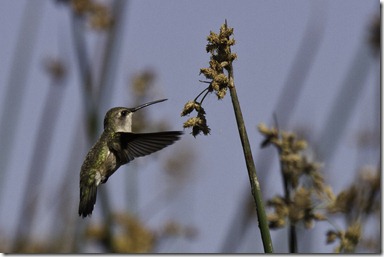Phil’s Photo Monday
Photo by: Phil Robertson
Cool Facts
In the first half of the 20th century, the Anna’s Hummingbird bred only in northern Baja California and southern California. The planting of exotic flowering trees provided nectar and nesting sites, and allowed the hummingbird to greatly expand its breeding range.
The dive display of the Anna’s Hummingbird lasts about 12 seconds, and the male may fly to a height of 40 m (131 feet) during the display. He starts by hovering two to four meters (6-13 feet) in front of the display object (hummingbird or person), and then climbs in a wavering fashion straight up. He plummets in a near-vertical dive from the top of the climb and ends with an explosive squeak within half a meter of the display object. He then makes a circular arc back to the point where he began. On sunny days the dives are oriented so that the sun is reflected from the iridescent throat and crown directly at the object of the dive.
On rare occasions, bees and wasps may become impaled on the bill of an Anna’s Hummingbird, causing the bird to starve to death.
Hummingbirds are strictly a New World animal. They fascinated the first Europeans who arrived on the continent. Christopher Columbus wrote about them and many wondered if they were a cross between a bird and an insect (at one point being called “flybirds”). Later, their feathers became fashionable ornaments in Europe (a practice that has thankfully fallen out of favor).
What do you call a flock of hummingbirds? Few animals have so many applicable terms, and none so beautiful. Instead of calling them a flock, choose between a bouquet, a glittering, a hover, a shimmer, or a tune of hummingbirds.
Native Americans held hummingbirds in high esteem. Many of their legends describe them as busily bring the rain to quench eruptions or poking holes in the night sky that became the stars. The Navajo say that the characteristic mating dive is a way for them to check what is above the blue of the sky.
The iridescent throat patch of male hummingbirds is called a gorget. The Anna’s gorget extends over its head, making it more of a balaclava than a bib. Oddly, female Anna’s have a tiny red gorget—females of most species have none.
Anna’s Hummingbirds normally have a body temperature of around 107 degrees Fahrenheit—that’s a scorching temperature for a human. When outside temperatures fall, Anna’s and many other species of hummingbirds enter torpor. Their breathing and heart rate slow, and their body temperature can fall as low as 48 degrees Fahrenheit When the temperature warms, the hummingbirds can become active again in a few minutes.
Hummingbirds have tiny legs and can neither hop nor walk, though they can sort of scoot sideways while perched.
Habitat
Open Woodland
Anna’s Hummingbirds are common in urban and suburban settings as well as wilder places such as chaparral, coastal scrub, oak savannahs, and open woodland. They are notably common around eucalyptus trees, even though eucalyptus was only introduced to the West Coast in the mid-nineteenth century.
Food
Nectar
Anna’s Hummingbirds eat nectar from many flowering plants, including currant, gooseberry, manzanita, and many introduced species such as eucalyptus. They also eat a wide array of insects from understory leaves, crevices, stream banks, or caught in spider webs, plucked from the air, or taken from flowers. Primarily they target smaller insects, like midges, whiteflies, and leaf hoppers (one female was found with 32 leafhoppers in her stomach at once). They also help themselves to tree sap (and insects caught in it) leaking out from holes made by sapsuckers.
Nesting
Nesting Facts
Clutch Size
2 eggs
Number of Broods
2-3 broods
Egg Length
0.5–0.6 in
Egg Width
0.3–0.4 in
Incubation Period
16 days
Nestling Period
20 days
Egg Description
White.
Condition at Hatching
Eyes closed, very little down, virtually helpless.
Nest Description
The female builds the nest out of plant down and spider webs, sitting in the nest and building the cup rim up around her. Nests take around a week to build and are 1 inch tall by 1.5 inches in diameter. They may be built of cattail, willow, leaves, thistle, or small feathers and bound together by spider webs or insect cocoons. They may decorate the outside with lichens, mosses, or even paint chips. They sometimes steal these from other active nests.
Nest Placement
Tree
Females choose the nest site, usually a horizontal branch of trees or shrubs 6-20 feet off the ground (occasionally higher) near a source of nectar. They often build nests in oak, sycamore, or eucalyptus trees, but they may use vines, shrubs or even poison oak. The only plants they appear to avoid are conifers.
Behavior
Hovering
Anna’s Hummingbirds hover deftly and zip from flower to flower. They are at their most splendid when performing their wild courtship dives. A male flies as high as 130 feet in the air and then plummets toward the ground (and the watching female), where he lets loose a unique short high-pitched noise made by air whipping through his tail feathers. As courtship progresses, the male chases a receptive female, who leads him toward her nest site, and perches again. The male then performs a “shuttle display,” where he swings back and forth about a foot above the female, keeping his body horizontal and his head down toward the female, often singing an intense song. When males are not feeding or performing, they often sit fairly high in a bush or small tree, noisily chattering. Males and females do not form pairs, and both sexes likely mate with more than one individual per season. Only the females care for the young.
Conservation
status via IUCN
Least Concern
The Anna’s Hummingbird is the most common hummingbird on the West Coast, and it has thrived alongside human habitation. Its range has increased dramatically since the 1930s, when it was found only in California and Baja California. Thanks to widespread backyard feeders and introduced trees such as eucalyptus, it now occurs in healthy numbers all the way to Vancouver, Canada. Even so, Anna’s Hummingbirds can fall prey to outdoor cats in gardens where flowers grow close to the ground.
Source: http://www.allaboutbirds.org/guide/Annas_Hummingbird/lifehistory

 (916) 434-2759
(916) 434-2759



